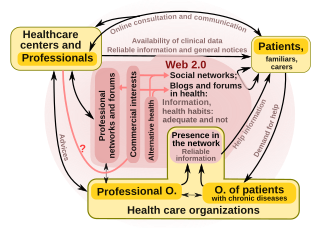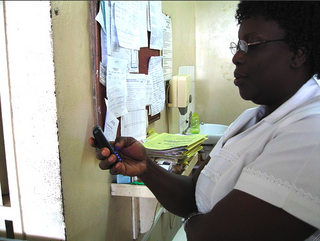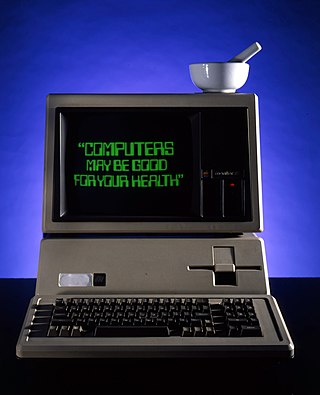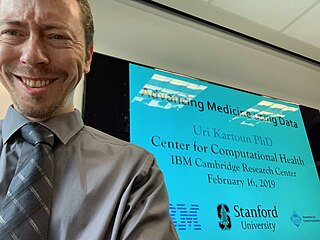Related Research Articles
eHealth describes healthcare services which are supported by digital processes, communication or technology such as electronic prescribing, Telehealth, or Electronic Health Records (EHRs). The use of electronic processes in healthcare dated back to at least the 1990s. Usage of the term varies as it covers not just "Internet medicine" as it was conceived during that time, but also "virtually everything related to computers and medicine". A study in 2005 found 51 unique definitions. Some argue that it is interchangeable with health informatics with a broad definition covering electronic/digital processes in health while others use it in the narrower sense of healthcare practice using the Internet. It can also include health applications and links on mobile phones, referred to as mHealth or m-Health.
A personal health record (PHR) is a health record where health data and other information related to the care of a patient is maintained by the patient. This stands in contrast to the more widely used electronic medical record, which is operated by institutions and contains data entered by clinicians to support insurance claims. The intention of a PHR is to provide a complete and accurate summary of an individual's medical history which is accessible online. The health data on a PHR might include patient-reported outcome data, lab results, and data from devices such as wireless electronic weighing scales or from a smartphone.

Deborah Louise McGuinness is an American computer scientist and researcher at Rensselaer Polytechnic Institute (RPI). She is a professor of Computer, Cognitive and Web Sciences, Industrial and Systems Engineering, and an endowed chair in the Tetherless World Constellation, a multidisciplinary research institution within RPI that focuses on the study of theories, methods and applications of the World Wide Web. Her fields of expertise include interdisciplinary data integration, artificial intelligence, specifically in knowledge representation and reasoning, description logics, the semantic web, explanation, and trust.
An e-patient is a health consumer who participates fully in his/her medical care, primarily by gathering information about medical conditions that impact them and their families, using the Internet and other digital tools. The term encompasses those who seek guidance for their own ailments and the friends and family members who go online on their behalf. E-patients report two effects of their health research: "better health information and services, and different, but not always better, relationships with their doctors."

Web science is an emerging interdisciplinary field concerned with the study of large-scale socio-technical systems, particularly the World Wide Web. It considers the relationship between people and technology, the ways that society and technology co-constitute one another and the impact of this co-constitution on broader society. Web Science combines research from disciplines as diverse as sociology, computer science, economics, and mathematics.

Gunther Eysenbach is a German-Canadian researcher on healthcare, especially health policy, eHealth, and consumer health informatics.
Online health communities are online social networks related to health. They primarily provide a means for patients and their families to learn about illnesses, to seek and offer social support, and to connect with others in similar circumstances. These online groups can be composed of individuals with illnesses, groups of medical professionals with shared interests, non-professional caregivers and family of patients, or a combination. The term "online health community" is primarily academic jargon.

"Health 2.0" is a term introduced in the mid-2000s, as the subset of health care technologies mirroring the wider Web 2.0 movement. It has been defined variously as including social media, user-generated content, and cloud-based and mobile technologies. Some Health 2.0 proponents see these technologies as empowering patients to have greater control over their own health care and diminishing medical paternalism. Critics of the technologies have expressed concerns about possible misinformation and violations of patient privacy.

mHealth is an abbreviation for mobile health, a term used for the practice of medicine and public health supported by mobile devices. The term is most commonly used in reference to using mobile communication devices, such as mobile phones, tablet computers and personal digital assistants (PDAs), and wearable devices such as smart watches, for health services, information, and data collection. The mHealth field has emerged as a sub-segment of eHealth, the use of information and communication technology (ICT), such as computers, mobile phones, communications satellite, patient monitors, etc., for health services and information. mHealth applications include the use of mobile devices in collecting community and clinical health data, delivery/sharing of healthcare information for practitioners, researchers and patients, real-time monitoring of patient vital signs, the direct provision of care as well as training and collaboration of health workers.
Patient participation is a trend that arose in answer to medical paternalism. Informed consent is a process where patients make decisions informed by the advice of medical professionals.
Health 3.0 is a health-related extension of the concept of Web 3.0 whereby the users' interface with the data and information available on the web is personalized to optimize their experience. This is based on the concept of the Semantic Web, wherein websites' data is accessible for sorting in order to tailor the presentation of information based on user preferences. Health 3.0 will use such data access to enable individuals to better retrieve and contribute to personalized health-related information within networked electronic health records, and social networking resources.

The Wikipedia online encyclopedia has, since the late 2000s, served as a popular source for health information for both laypersons and, in many cases, health care practitioners. Health-related articles on Wikipedia are popularly accessed as results from search engines, which frequently deliver links to Wikipedia articles. Independent assessments have been made of the number and demographics of people who seek health information on Wikipedia, the scope of health information on Wikipedia, and the quality of the information on Wikipedia.

Health information on the Internet refers to all health-related information communicated through or available on the Internet.
Infodemiology was defined by Gunther Eysenbach in the early 2000s as information epidemiology. It is an area of science research focused on scanning the internet for user-contributed health-related content, with the ultimate goal of improving public health. It is also defined as the science of mitigating public health problems resulting from an infodemic.
Digital therapeutics, a subset of digital health, are evidence-based therapeutic interventions driven by high quality software programs to prevent, manage, or treat a medical disorder or disease. Digital therapeutic companies should publish trial results inclusive of clinically meaningful outcomes in peer-reviewed journals. The treatment relies on behavioral and lifestyle changes usually spurred by a collection of digital impetuses. Because of the digital nature of the methodology, data can be collected and analyzed as both a progress report and a preventative measure. Treatments are being developed for the prevention and management of a wide variety of diseases and conditions, including type 1 & type II diabetes, congestive heart failure, obesity, Alzheimer's disease, dementia, asthma, substance abuse, ADHD, hypertension, anxiety, depression, and several others. Digital therapeutics often employ strategies rooted in cognitive behavioral therapy.
Digital medicine refers to the application of advanced digital technologies, such as artificial intelligence, machine learning, and big data analytics, to improve patient outcomes and healthcare delivery. It involves the integration of technology and medicine to facilitate the creation, storage, analysis, and dissemination of health information, with the aim of enhancing clinical decision-making, improving patient care, and reducing costs.
Health data is any data "related to health conditions, reproductive outcomes, causes of death, and quality of life" for an individual or population. Health data includes clinical metrics along with environmental, socioeconomic, and behavioral information pertinent to health and wellness. A plurality of health data are collected and used when individuals interact with health care systems. This data, collected by health care providers, typically includes a record of services received, conditions of those services, and clinical outcomes or information concerning those services. Historically, most health data has been sourced from this framework. The advent of eHealth and advances in health information technology, however, have expanded the collection and use of health data—but have also engendered new security, privacy, and ethical concerns. The increasing collection and use of health data by patients is a major component of digital health.
Natasha Gajewski (née Rana) is the CEO and Founder of Symple Health.

EMRBots are experimental artificially generated electronic medical records (EMRs). The aim of EMRBots is to allow non-commercial entities to use the artificial patient repositories to practice statistical and machine-learning algorithms. Commercial entities can also use the repositories for any purpose, as long as they do not create software products using the repositories.
References
- ↑ McHattie LS, Cumming G, French T. Transforming Patient Experience: Health Web Science Meets Medicine 2.0 Med 2.0 2014;3(1):e2 URL:http://www.medicine20.com/2014/1/e2 DOI: 10.2196/med20.3128.
- ↑ Brooks, Elizabeth H.; Cumming, Grant P.; Luciano, Joanne S. (2011-01-01). "Health web science". Proceedings of the second international workshop on Web science and information exchange in the medical web. MedEx '11. New York, NY, USA: ACM. pp. 11–14. doi:10.1145/2064741.2064746. ISBN 9781450309509. S2CID 38123837.
- ↑ "ACM".
- ↑ "Medicine 2.0'12 (Boston, USA)". www.medicine20congress.com. Retrieved 2016-03-08.
- ↑ Luciano, Joanne S.; Cumming, Grant P.; Wilkinson, Mark D.; Kahana, Eva (2013-01-01). "The emergent discipline of health web science". Journal of Medical Internet Research. 15 (8): e166. doi: 10.2196/jmir.2499 . ISSN 1438-8871. PMC 3758025 . PMID 23968998.
- ↑ Luciano, Joanne S.; Cumming, Grant P.; Wilkinson, Mark D.; Kahana, Eva (2013-01-01). "The emergent discipline of health web science". Journal of Medical Internet Research. 15 (8): e166. doi: 10.2196/jmir.2499 . ISSN 1438-8871. PMC 3758025 . PMID 23968998.
- ↑ Luciano, Joanne S. (2013). "Health Web Science". Foundations and Trends in Web Science. 4 (4): 269–419. doi:10.1561/1800000019.
- ↑ "WK9 - Life Web Science Workshop - ACM Web Science 2013". www.websci13.org. Retrieved 2016-03-08.
- ↑ Gillam et al. (2009) The healthcare singularity and the age of semantic medicine. In The Fourth Paradigm Data-Intensive Scientific Discovery.Microsoft Research Washington.
- ↑ Hood, Leroy; Friend, Stephen H. (2011). "Predictive, personalized, preventive, participatory (P4) cancer medicine". Nature Reviews Clinical Oncology. 8 (3): 184–187. doi:10.1038/nrclinonc.2010.227. PMID 21364692. S2CID 9074524.
- ↑ "Web Science Trust". Web Science Trust. Archived from the original on 2012-06-29. Retrieved 2016-03-08.
- ↑ "Web Observatory". Web Science Trust. Retrieved 2016-03-08.
- ↑ Hall, Wendy and Tiropanis, Thanassis (2012) Web Evolution and Web Science. Computer Networks, 56, (18), 3859-3865. Eprints:http://eprints.soton.ac.uk/343770/
- ↑ Tiropanis, T, Hall, W, Shadbolt N, De Roure, David Contractor N, Hendler J. The Web Science Observatory Archived 2016-03-04 at the Wayback Machine 2013.
- ↑ Gillam et al.(2009) The healthcare singularity and the age of semantic medicine. In The Fourth Paradigm Data-Intensive Scientific Discovery. Microsoft Research Washington.